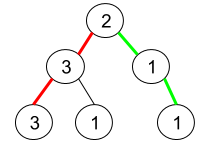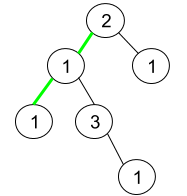[LeetCode] 1457. Pseudo-Palindromic Paths in a Binary Tree
Given a binary tree where node values are digits from 1 to 9. A path in the binary tree is said to be pseudo-palindromic if at least one permutation of the node values in the path is a palindrome.
Return the number of pseudo-palindromic paths going from the root node to leaf nodes.
Example 1:
Input: root = [2,3,1,3,1,null,1]
Output: 2
Explanation: The figure above represents the given binary tree. There are three paths going from the root node to leaf nodes: the red path [2,3,3], the green path [2,1,1], and the path [2,3,1]. Among these paths only red path and green path are pseudo-palindromic paths since the red path [2,3,3] can be rearranged in [3,2,3] (palindrome) and the green path [2,1,1] can be rearranged in [1,2,1] (palindrome).
Example 2:
Input: root = [2,1,1,1,3,null,null,null,null,null,1]
Output: 1
Explanation: The figure above represents the given binary tree. There are three paths going from the root node to leaf nodes: the green path [2,1,1], the path [2,1,3,1], and the path [2,1]. Among these paths only the green path is pseudo-palindromic since [2,1,1] can be rearranged in [1,2,1] (palindrome).
Example 3:
Input: root = [9]
Output: 1
Constraints:
The number of nodes in the tree is in the range [1, 105].
1 <= Node.val <= 9
二叉树中的伪回文路径。
给你一棵二叉树,每个节点的值为 1 到 9 。我们称二叉树中的一条路径是 「伪回文」的,当它满足:路径经过的所有节点值的排列中,存在一个回文序列。
请你返回从根到叶子节点的所有路径中 伪回文 路径的数目。
思路
前序遍历 + 回溯。用前序遍历的方法遍历整棵树,在遍历的过程中记录用一个长度为 10 的数组记录每个不同 node.val 的出现次数。遍历到叶子节点的时候看一下数组里出现次数为奇数的元素有几个,如果有超过1个元素的出现次数为奇数,那么当前这条从根节点到叶子节点的路径就不是回文路径。
复杂度
时间O(n)
空间O(n)
代码
Java实现
1 | |